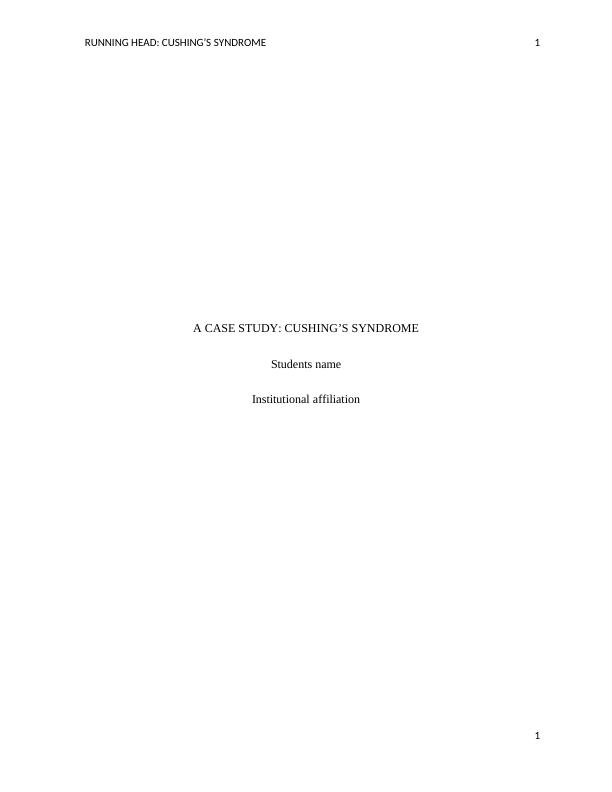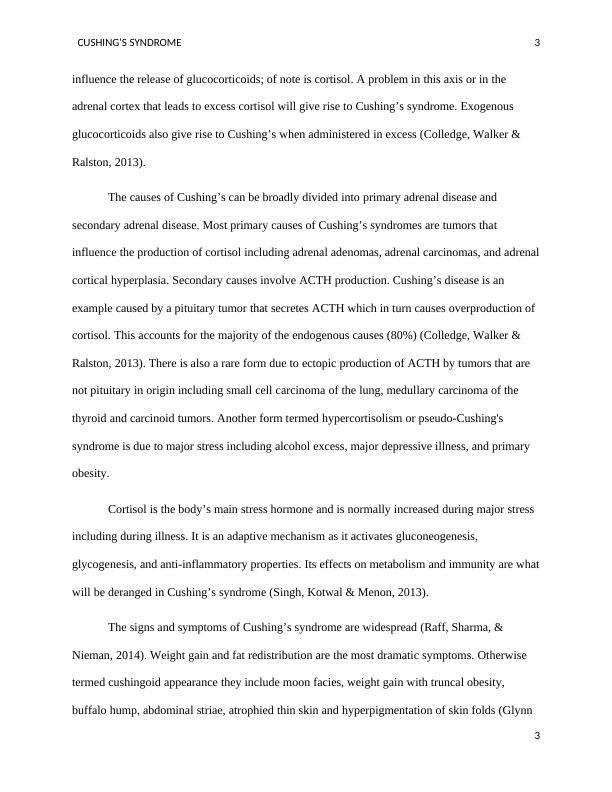Assignment on Cushing's Syndrome
Added on 2021-04-16
9 Pages2447 Words46 Views
RUNNING HEAD: CUSHING’S SYNDROME 1A CASE STUDY: CUSHING’S SYNDROMEStudents nameInstitutional affiliation1

CUSHING’S SYNDROME 2A case study of Susan Summers, a forty-year-old female obese patient admitted to the hospital for laparoscopic right adenectomy under general anesthesia due to Cushing’s syndrome. She was obese at 90kg with a BMI of 35kg/m2. She was a diagnosed type 2 diabetic and used nine units of alcohol at night day. She was admitted for removal of a benign tumor of her right adrenal gland. Her immediate post-operative recovery was uneventful. On return to the ward, hervitals become deranged with a respiratory rate of 30 breaths per minute, blood pressure of 160/90mmHg, pulse rate of 128bpm, and a temperature of 35.00C. She also had a low urine output of 5mls within one hour. She, however, did not have any pain.The present paper will give a detailed etiology and pathophysiology of Cushing’s syndrome; the patient’s main presenting clinical problem. It will outline the causes, signs, and symptoms of the said condition. It will also describe Susan’s deranged vital signs with reference to the normal vitals and try to link them to her presenting complain and the surgery. A brief outline of the effect of hypothermia on vital signs and reasons for the urine output will also be given. With the problem adequately described, priorities of care will be discussed with emphasis on vital signs and safe care 2 hours postoperative. Appropriate referral MDT team to effectively handle the patient thereafter will be given. Lastly, a summary of the entire work.Cushing’s syndrome is a syndrome of excess cortisol, a hormone produced by the human adrenal glands. It is a disease mostly seen in women with a male to female ratio of 1:5 (Colledge,Walker & Ralston, 2013). The peak incidence of the disease is between 30-50 years. The adrenalcortex is an endocrine gland that produces cortisol and androgens. It is closely regulated by the hypothalamic-pituitary-adrenal axis through a cascade of hormones and negative feedback. The hypothalamus produces corticotropin-releasing hormone (CRH) which stimulates the pituitary gland to release adrenocorticotrophic hormone (ACTH). ACTH acts on the adrenal cortex to 2

CUSHING’S SYNDROME 3influence the release of glucocorticoids; of note is cortisol. A problem in this axis or in the adrenal cortex that leads to excess cortisol will give rise to Cushing’s syndrome. Exogenous glucocorticoids also give rise to Cushing’s when administered in excess (Colledge, Walker & Ralston, 2013).The causes of Cushing’s can be broadly divided into primary adrenal disease and secondary adrenal disease. Most primary causes of Cushing’s syndromes are tumors that influence the production of cortisol including adrenal adenomas, adrenal carcinomas, and adrenalcortical hyperplasia. Secondary causes involve ACTH production. Cushing’s disease is an example caused by a pituitary tumor that secretes ACTH which in turn causes overproduction of cortisol. This accounts for the majority of the endogenous causes (80%) (Colledge, Walker & Ralston, 2013). There is also a rare form due to ectopic production of ACTH by tumors that are not pituitary in origin including small cell carcinoma of the lung, medullary carcinoma of the thyroid and carcinoid tumors. Another form termed hypercortisolism or pseudo-Cushing's syndrome is due to major stress including alcohol excess, major depressive illness, and primary obesity.Cortisol is the body’s main stress hormone and is normally increased during major stress including during illness. It is an adaptive mechanism as it activates gluconeogenesis, glycogenesis, and anti-inflammatory properties. Its effects on metabolism and immunity are whatwill be deranged in Cushing’s syndrome (Singh, Kotwal & Menon, 2013).The signs and symptoms of Cushing’s syndrome are widespread (Raff, Sharma, & Nieman, 2014). Weight gain and fat redistribution are the most dramatic symptoms. Otherwise termed cushingoid appearance they include moon facies, weight gain with truncal obesity, buffalo hump, abdominal striae, atrophied thin skin and hyperpigmentation of skin folds (Glynn 3

End of preview
Want to access all the pages? Upload your documents or become a member.
Related Documents
NRSG258 Acute Care Nursing : Assignmentlg...
|10
|2874
|30
Adrenalectomy Pathophysiology and Nursing Carelg...
|9
|2558
|61
Cushing Syndrome: Aetiology, Pathophysiology, Post-operative Deterioration and Nursing Managementlg...
|6
|2274
|418
KIN 4043 - Therapeutic Case Studylg...
|12
|4547
|42
(PDF) Cushing's syndrome Diseaselg...
|9
|2568
|69
(PDF) Routine postoperative nursing managementlg...
|9
|2512
|147
